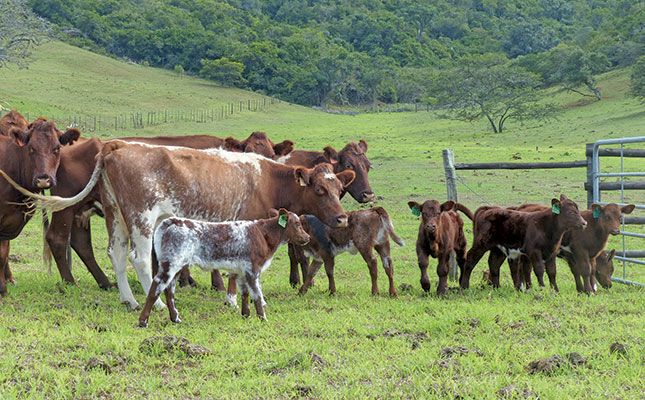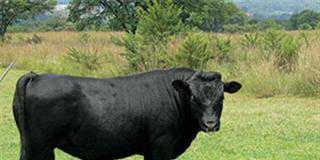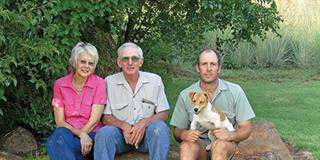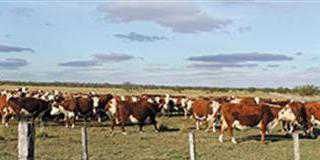
Photo: Mike Burgess
According to Allistair Brown, one of the reasons he and his brother, Laurence, chose the Shorthorn breed to enter the beef stud industry in 2003 was its decline in popularity in South Africa over the past few decades.
This, says Allistair, is despite the Shorthorn’s genetic contribution to more than 40 breeds across the world, not least of all the Bonsmara.
“Because there are not many around in South Africa, we felt it was a quality breed we could take and go somewhere with,’’ he says.
“We’re focusing on driving maternal traits, together with the complementary carcass traits associated with Shorthorns, while marketing the commercial advantages of the renowned heterosis offered by Shorthorns in crossbreeding programmes across the world.’’
The Beef Shorthorn
The Brown brothers, who grew up on a livestock farm near Cathcart in the Eastern Cape, inherited some Hereford and Braford-type animals in the early 2000s from their father, who was scaling back his farming operation.
They ran them in the Cathcart and Queenstown districts, a venture that proved to be the platform for their future Beef Shorthorn initiative. In the meantime, they conducted research on the breed, which included reading the works of Prof Jan Bonsma and Laurence Lasater, that confirmed the British breed’s global reach and rich history in South Africa since the mid-1800s.
In 2003, they committed to the British breed, and from the very beginning, made it their strategy to purchase as many South African Beef Shorthorn dam lines as possible (a large proportion from dispersal sales).
They then used them in a timed artificial insemination (TAI) programme, with semen sourced from Ireland, Australia, the US and Canada.
In 2009, the brothers relocated their cattle to the 236ha former dairy farm of Forest Glade near Alexandria, an area notorious for its virulent heartwater, redwater and gallsickness, and soon calved 41 cows and heifers.
Today, Forest Glade is home to not one, but two studs owned by the Browns, amounting to 120 registered females. Between three and six bulls are sold a year to mostly commercial farmers (a top price of R44 000 has been achieved) for use in crossbreeding programmes.
Between three and five of these bulls are Phase C performance-tested annually. Last year, one was announced as the Agricultural Research Council’s (ARC) National Special Performance Beef Shorthorn test class bull, a significant achievement for the brothers.
Two Shorthorn studs
The Duncraggan Beef Shorthorn stud of 100 females was built up by purchasing dam lines (and a bull) from breeders who included John Rigby (Makhanda); Robin Halse (Sterkstroom); Ted Matthews (Tsitsikamma region); Gray Edwards (Stutterheim) and the Primeston stud (Bedford).
Females were also bought at Halse and Matthews’ dispersal sales in 2007 and 2009 respectively.
To broaden the genetic base, in-calf Bonsmara cows were purchased from Norton Thompson’s Glen Glyde Bonsmaras near Komga in 2009, and eventually put to self-bred Beef Shorthorn bulls.
Offspring from this cross-breeding programme were introduced to the stud via the appendix system, and Allistair recalls how deeply impressed he was with the first-generation offspring, which showed exceptional hybrid vigour.
In 2013, the Primeston Beef Shorthorn stud, one of the oldest Shorthorn studs in the country, came onto the market. Although it had by then decreased to just seven cows, the herd can be traced back to 1861, when Messrs George King and Sons of Bedford imported a few dairy-type Shorthorn heifers and a bull from Britain.
During the 1800s, lactating Primeston cows were swapped for Shorthorns on British ships rounding South Africa en route to Australasia, an arrangement that proved to be an effective way of sourcing much-needed new genetics from Britain.
By the 1970s, the Primeston herd was being selected exclusively for beef, so when they presented themselves for sale about 40 years later, the Brown brothers jumped at the opportunity.
“We thought the stud would complement our operation,’’ recalls Allistair. “The herd consisted of stable, traditional, South African genetics.’’
Balance in breeding
Almost a third of calves on Forest Glade are the product of artificial insemination. With TAI conception rates ranging from 20% to 70%, depending on the severity of dry spells, the average intercalving period (ICP) of all stud cows is 402 days, despite individual cows with ICPs of below 365 days.
Females mated naturally (including all heifers) are done so in 65-day mating seasons to calve in autumn and spring. Two-year-old self-bred bulls are used on these females before being marketed at three years old as proven sires.
In a desperately dry 2018, a calving rate of 70% was achieved for naturally mated females, but the usual calving rate is well above 90%.
Selection for fertility, sufficient milk production, good udders and ease of calving are all important for ensuring effective maternal function.
However, to achieve both maternal function and effective post-weaning growth (expressed by efficient average daily gain and feed conversion rates) demands balance, as maternal function and post-weaning growth are antagonistic towards each other.
By understanding this need for balance in the selection process, the Browns have achieved considerable success over the past five years: they have bred fertile, medium-framed Beef Shorthorn cows able to produce quality weaners with average 205-day weaning weights of 223kg and 205kg for bull and heifer calves respectively.
According to Allistair, one of the most prudent decisions they have made in terms of selection has been to acquire the services of Ian Walsh of the Falkirk Scientific Foundation.
Animals are ultrasound-scanned for skin thickness, muscle, fat deposition (intramuscular fat and positive fats are paramount) and structural soundness (to ensure ease of calving and functional efficiency) at six-month intervals. All bulls are Falkirk Indexed, and it has been ascertained that a frame score of below six is best suited to the conditions on Forest Glade.
Consulting Walsh helped the Browns select the correct animals within the context of their type: “not too extreme, medium-framed and fertile”.
Record-keeping
Measurement of growth and performance is crucial. “The only thing we don’t weigh is the dam when she calves. We weigh at birth, pre-wean, wean, yearling and 18 months, while about five bulls undergo Phase C performance testing each year,” says Allistair.
The brothers rely heavily on estimated breeding values, including 200-day growth, milk production and calving ease direct, and agree that genomics is the next frontier of genetic predictability.
They also believe in the importance of ascertaining if an animal is functionally efficient by viewing it.
“There’s therefore always a place for good stockmanship,’’ says Allistair.
Management
Forest Glade has predominantly kikuyu pastures and natural veld. Value is added to pastures with no-till ryegrass, oats and legumes (12ha in 2018).
All cattle receive a phosphate/salt/molasses meal mixture ad lib throughout the year, and an energy and protein lick is given to cows that have calved. Additionally, AI cows receive mineral and vitamin injections before and after the procedure.
Cattle are dipped 10 to 12 times a year, and high levels of tick resistance to products (in some cases 90%) have been a significant challenge over the years. A combination of pour-on dips and injectables together with tick growth inhibitors is proving successful, however.
A standard inoculation and dosing programme is adhered to, but special attention is given to clostridial diseases.
In addition to traditional forms of identification, by the end of 2019 all sale breeding cattle will be DNA-parentage verified.
More than 50% of all cattle in the Duncraggan herd, except calves, are already DNA-verified.
Email Allistair Brown at [email protected].











